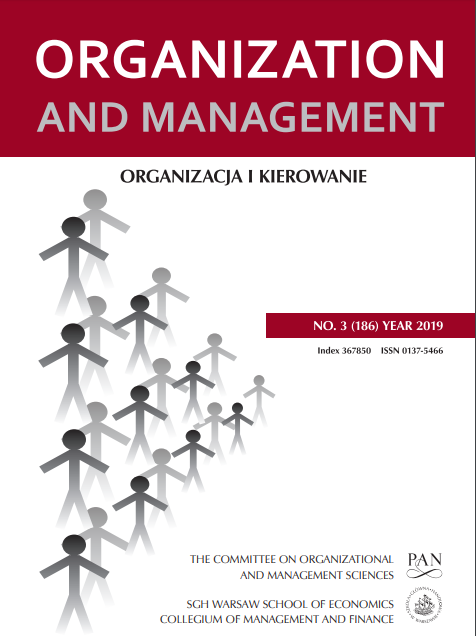Entrepreneurial Mobility – Concept, Dimensions, Meaning
Main Article Content
Abstract
Searching for factors that are strategically important for the organization and maintaining a competitive advantage means that organizations are looking for such factors that will allow them to cross their borders. One of them is entrepreneurial mobility. Therefore, the aim of this article is to identify the conceptualization of the essence of the notion of entrepreneurial mobility, to determine its dimensions and to show the relationship with strategic entrepreneurship, the theory of resources and the theory of entrepreneurial behavior. The obtained conclusions allow to state that entrepreneurial mobility undertaken by enterprises may also be, thanks to possessed resources, competencies and the use of opportunities in the environment an essential moderating factor in maintaining and/or achieving a competitive advantage. The study has a theoretical character and was based on the analysis of literature using the method of analysis and criticism of the literature.
Article Details
References
inheritance: Spin-out generation, growth and survival, Academy of Management Journal
47(4): 501–522.
[2] Dokko G., Wu G.A. [2017], Boundary-crossing job mobility, new product area entry, and
the performance of entrepreneurial ventures, Research in the Sociology of Organizations
50: 419–448.
[3] Bańka A. [2015], Intencjonalne konstruowanie przyszłości i wyprzedzające realizowanie
celów: walidacja Skali Proaktywności Ogólnej, Czasopismo Psychologiczne 21(1): 97–115.
[4] Bakker A.B., Tims M., Derks D. [2012], Proactive personality and job performance: The
role of job crafting and work engagement, Human Relations 65(10): 1359–1378.
[5] Bratnicka K., Dyduch W. [2014], Strategiczna przedsiębiorczość. Koncepcja i pomiar, in:
Zarządzanie strategiczne. Rozwój koncepcji i metod, R. Krupski (ed.), Prace Naukowe
WWSZIP 27(2), Wałbrzych: 167–192.
[6] Frederiksen L., Wennberg K., Balachandran Ch. [2016], Mobility and entrepreneurship:
Evaluating the scope of knowledge‐based theories of entrepreneurship, Entrepreneurship
Theory and Practice 40(2): 359–380.
[7] Groysberg A., Nanda M., Prats J. [2009], Does individual performance affect entrepreneurial
mobility? Empirical evidence from the financial analysis market, Journal of Financial
Transformation 25: 95–106.
[8] Hamel G., Prahalad C.K. [1994], Competing for the future, Harvard Business School
Press, Boston, MA.
[9] Hitt M.A., Ireland R.D., Sirmon G., Trahms Ch.A. [2011], Strategic entrepreneurship:
Creating value for individuals, organizations and society, Academy of Management
Perspectives: 57–75.
[10] Ireland R.D., Hitt M.A., Sirmon D.G. [2003], A model of strategic entrepreneurship: The
construct and its dimensions, Journal of Management 29(6): 963–989.
[11] Kaleta A., Sołoducho-Pelc L. [2016], Integracja przedsiębiorczości i zarządzania strategicznego w koncepcji strategicznej przedsiębiorczości – ocena przeszłości i sugestie
na przyszłość, Research Papers of the Wroclaw University of Economics/Prace Naukowe
Uniwersytetu Ekonomicznego we Wrocławiu 419: 56–67.
[12] Kuratko D.F., Ireland R.D., Covin J.G., Hornsby J.S. [2005], A model of middle-level
managers’ entrepreneurial behavior, Entrepreneurship Theory and Practice 29(6): 699–716.
[13] Latif A., Yeasmin A. [2015], Entrepreneurial mobility in industrial estates of Bangladesh:
A study on selected industrial estates of Sylhet division, Bangladesh, Management Studies
and Economic Systems 1(3): 141–146.
[14] Lundmark E., Waern A. [2008], What is mobile in entrepreneurship? Helix Working
Papers, Linköpings Universitet.
[15] Matejun M. [2015], Absorpcja wsparcia w zarządzaniu rozwojem mikro, małych i średnich przedsiębiorstw – podejście strategiczne, Publishing House of Lodz University of
Technology, Łódź.
[16] Pauli U., Osowska R. [2018], Building entrepreneurial potential abroad – exploring
return migrant experience, International Journal of Entrepreneurial Behavior&Research.
[17] Shane S. [2000], Prior knowledge and the discovery of entrepreneurial opportunities,
Organization Science 11(4): 448–469.
[18] Szarucki M. [2011], Przedsiębiorczość strategiczna a przewaga konkurencyjna przedsiębiorstwa, Zeszyty Naukowe Uniwersytetu Ekonomicznego w Krakowie 856, Cracow: 73–90.
[19] Wright M. [2011], Entrepreneurial mobility, Research Methodology in Strategy and
Management 6: 137–159.
[20] Wright M. [2012], Entrepreneurial mobility, resource orchestration and context’, in:
F. Welter, D. Smallbone, Van Gils (eds.), Entrepreneurial processes in a changing economy.
Frontiers in European entrepreneurship research, Edward Elgar, London: 6–24.
[21] Zahra S.A., Wright M. [2011], Entrepreneurship’s next act, Academy of Management
Perspectives 25(4): 67–83.
[22] Zakrzewska-Bielawska A. [2016], Paradoks eksploracji i eksploatacji – ambidexterity
w zarządzaniu strategicznym, Prace Naukowe UE we Wrocławiu 420: 439–449.
[23] Zakrzewska-Bielawska A. [2017], Ambidexterity jako zdolność dynamiczna w odpowiedzi
na niepewność otoczenia, Studia Oeconomica Posnaniensia 5(9): 174–190.
